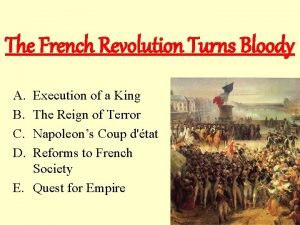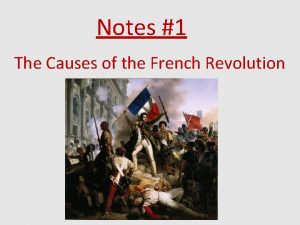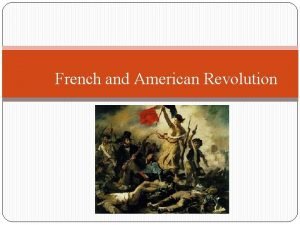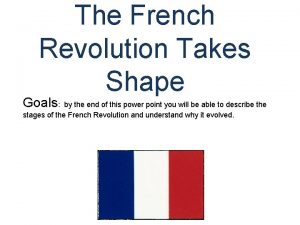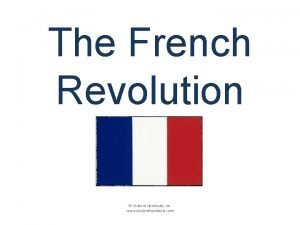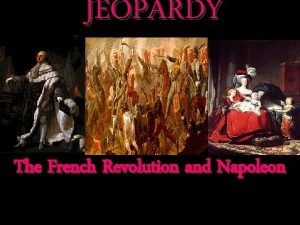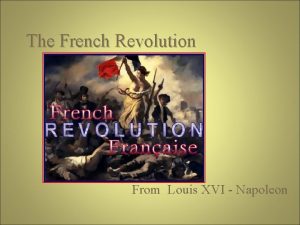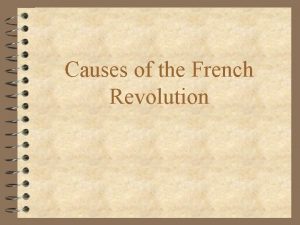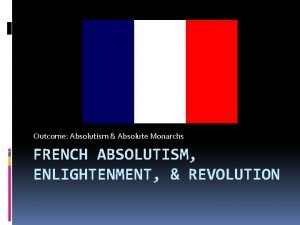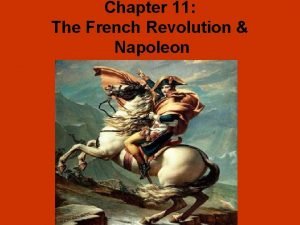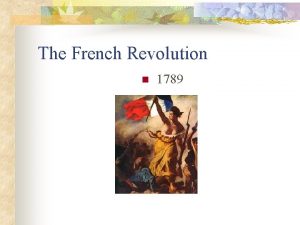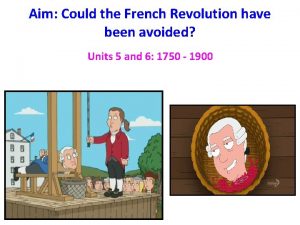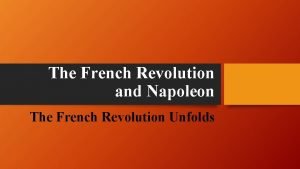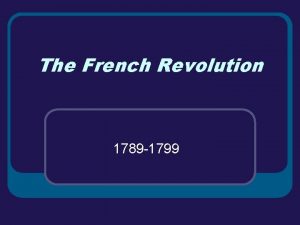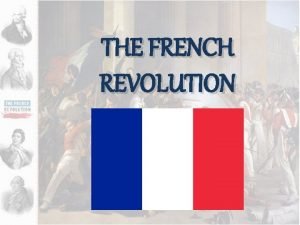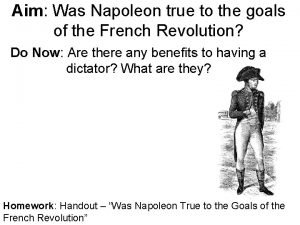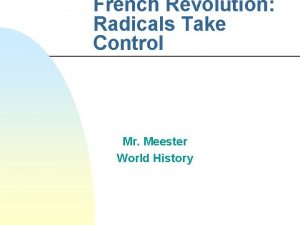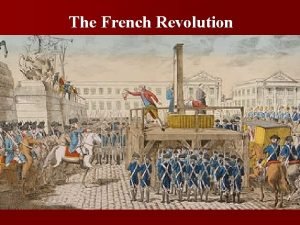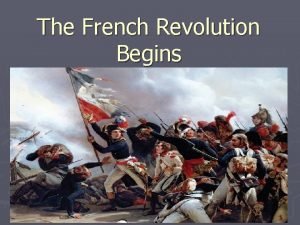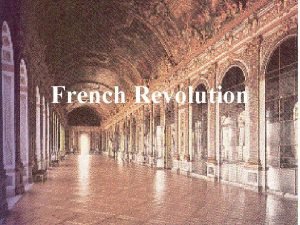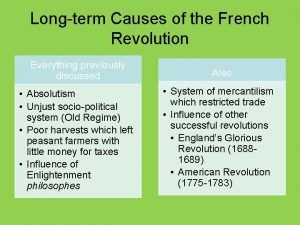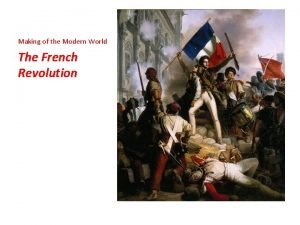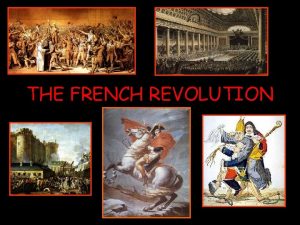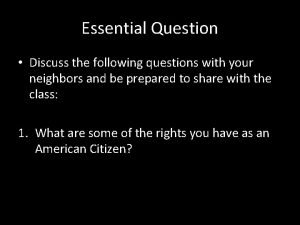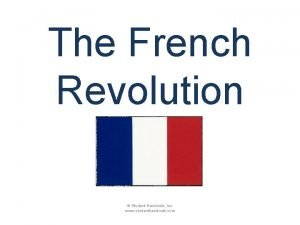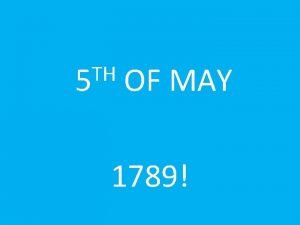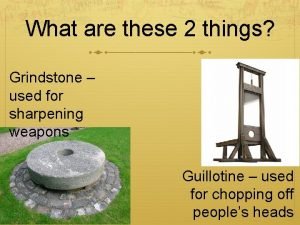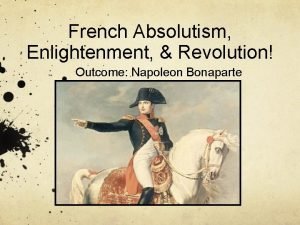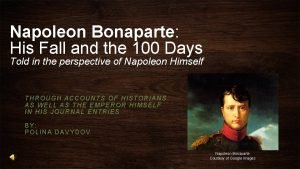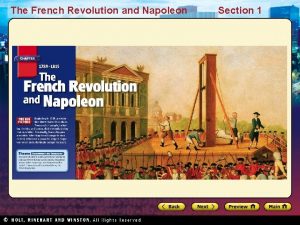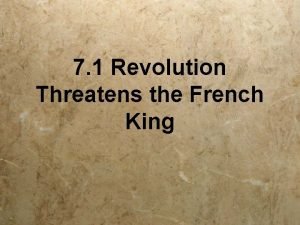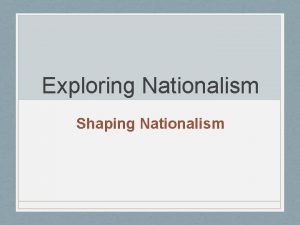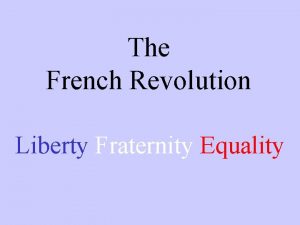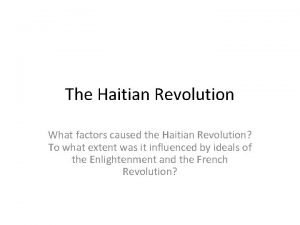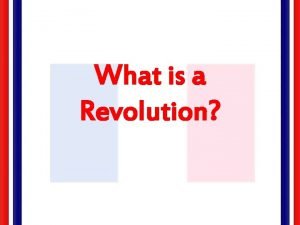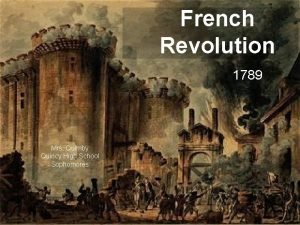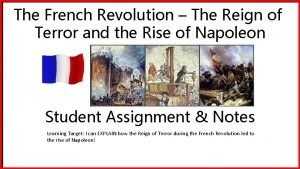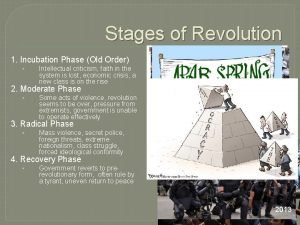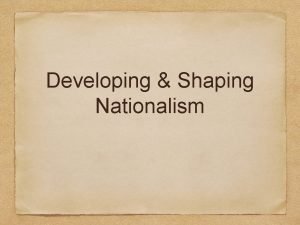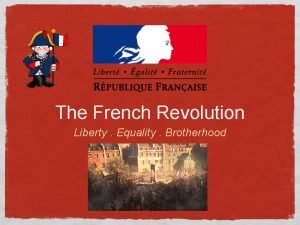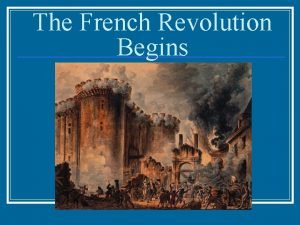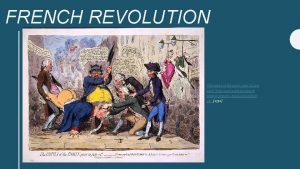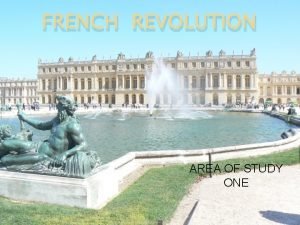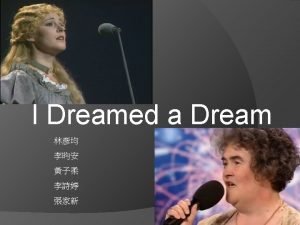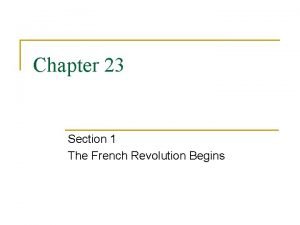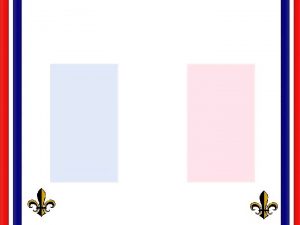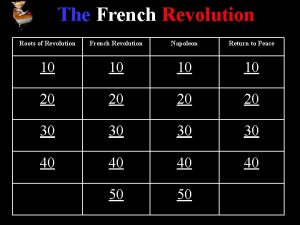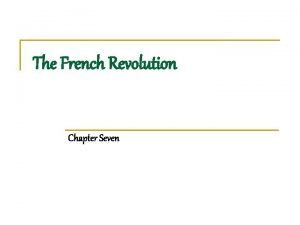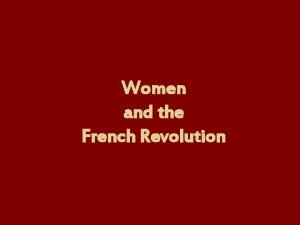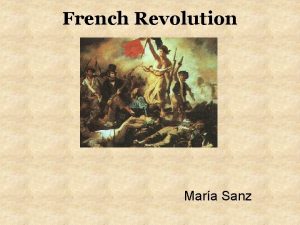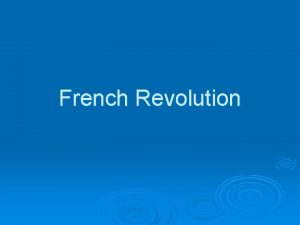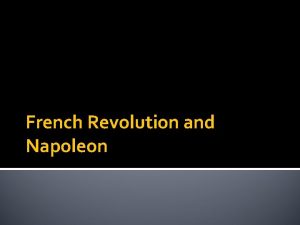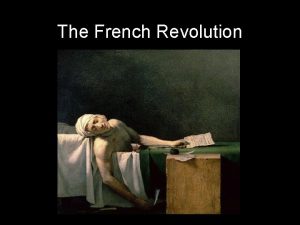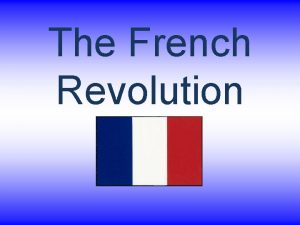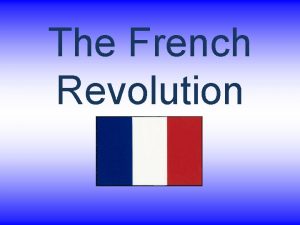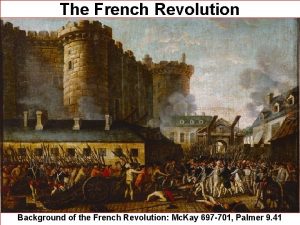The French Revolution DO NOW 1 What was



































































- Slides: 67

The French Revolution

DO NOW: 1. What was meant by the “Old Regime? ” 2. Explain how the following quote reflects the state/condition of French society on the eve of Revolution (1789): Ø “It was the best of times, it was the worst of times. ” Ø Does anyone know what book this quote is taken from? ? ?

France Ø By the death of Louis XIV, France was the strongest nation in Europe • Strongest army • Navy 2 nd only to Britain • Versailles the envy of monarchs • Paris the center of culture & learning

The French Revolution (1789 -99) I – Causes 1. Abuses of the “Old Regime” Ø Traditional political & social structure in France which included: a) Absolute rule of the king These Bourbon monarchs centralized power, frequently involved France in costly wars, spent heavily on construction projects & spent huge sums on their lavish lifestyles. Louis XIV (1643 -1715) Louis XV (1715 -1774)

Abuses of the “Old Regime” b) Feudal ownership of land • Nobility owned large portions of land • Peasants who lived on the land forced to work & pay taxes to nobles

Abuses of the “Old Regime” c) Society represented: “INEQUALITY” Ø 3 classes or “Estates” 1 st estate = clergy 2 nd estate = nobility 3 rd estate = everyone else

1 st Estate Catholic clergy 1% of the population 2 nd Estate = nobles 2% of the population 3 rd Estate = “commoners” 97% of the population 80% of which are peasant farmers Also city artisans & workers And…the bourgeoisie

Abuses of the “Old Regime” Ø Disproportionate amount of the land, wealth, rights & privileges are with the 1 st two estates BUT the taxes are paid by the 3 rd estate. . . v 80% of whom are peasants Taille – land tax Gabelle – salt tax Tithe – Church tax Corvee – road tax or service Champart – farm resources

Socio-Economic Data, 1789

The French Urban Poor

Abuses of the “Old Regime” Ø Complaints: • Nobles & higher clergy dislike lack of power; Nobles want a “limited” monarchy. Many (especially higher clergy) opposed Enlightenment! • Bourgeoisie want rights, privileges & political influence similar to the nobility • Peasants & workers are tired of paying all the taxes as well as high prices & cost of living while wages were low (poor economy) Ø (Have the least $ yet pay the most in tax)

What message does this image convey about French society? Who do each of the figures represent? In addition to tax burden, poor weather in the 1780’s caused crop failures & food shortages.

Causes of the French Revolution 2. Enlightenment Thinkers – Inspire well educated bourgeoisie to demand change. Natural rights / freedoms • Separation of powers • Popular sovereignty • Criticisms of inequality & injustice “social contract” & people’s right to change government • •

Causes of the French Revolution 3. • • • Success of English & American Revolutions the ideals influenced French thinking Success in America inspired call for change Aiding Americans vs. British = costly Marquis de Lafayette Aided cause of American Independence

Causes of the French Revolution 4. DEBT – Financial Crisis by 1750’s… WHY? • Wars, extravagance of royal court, aid to Americans and outstanding loans. Ø 1780’s French government near bankruptcy Ø Poor were already overburdened with taxes Louis XV: “Apres moi, le deluge!”

Causes of the French Revolution Ø This financial crisis fell onto the lap of king Louis XVI grandson (1774 -1792) Ø Finance minister Jacques Necker realized a new source of revenue needed to be found. Necker recommended a tax on land which meant the clergy & nobles would have to pay.

Louis XVI Ø Not a bad ruler, but weak & indecisive • “wishy, washy Louis” Ø Fears noble reaction to this “attack” on their birthright of tax exemption Ø With pressure from nobility, decides to convene a meeting of the Estates-General; The representative body of France

Moderate start to Revolution II – The Estates-General • Louis XVI summons the Estates-General to help deal with the financial crisis. (May, 1789) • It had not met since 1614 Representatives of the 3 estates were chosen from throughout the country and met in Paris “cahiers” • List of complaints

The Estates-General 1. Voting is UNFAIR! • Each estate gets ONE vote… (3%) 1 st estate (300 delegates)=1 vote 2 nd estate (300 delegates)=1 vote (97%) 3 rd estate (over 600 delegates)=1 vote ***1 st two estates always vote together

The French Revolution 2. Call for voting reform rejected by King Louis XVI • 3 rd estate forms the National Assembly • Encouraged by Abbe’ Sieyes’ pamphlet: “What is the Third Estate? ” Abbe Sieyes “The 3 rd Estate Awakens”; the formation of the National Assembly (June 17, 1789) is the first act of the French Revolution.

“Tennis Court Oath” Ø Louis XVI refused to recognize this assembly & “locked them out” of the meeting hall. Ø Delegates of the National Assembly met at nearby tennis court pledged not to disband until France had a written constitution

Storming the Bastille Ø Louis orders members of all 3 estates to join National Assembly (1 man/1 vote) 3. By July, Louis masses troops & plots to stop the Assembly. . . (mistake) • riots in Paris (fear Louis’ troops) • July 14, 1789 the storming of the Bastille prison (symbol of tyranny)

“Bastille Day” – July 14 French Independence Day July 14, 1789, Parisian mobs storm the Bastille, prison. This emotional action against tyranny was also an effort to secure weapons. The 7 prisoners were freed and most of the garrison defenders were killed. ØLafayette & the National Guard restores order in Paris The “tricolor”

The Great Fear & Violence Ø (July-August) peasant violence spread throughout the countryside against nobles & the “Old Regime” (allegedly fearing noble/monarch retaliation) Ø Many nobles, fearful of spreading violence flee the country “emigres”

Moderate Phase of the Revolution Work of the National Assembly 1. What actions were taken by the National Assembly to end oppression, injustice & inequality? 2. What was the Declaration of the Rights of Man? (What influenced it? What did it say? What was its purpose? ) 3. How did the Nat. Assembly deal with France’s debt? 4. How did the Nat. Assembly deal with the Catholic clergy? 5. What kind of gov’t did the Constitution of 1791 create? 6. What was Louis XVI’s reaction to the changes & the coming constitution? 7. Why would other rulers fear the revolution in France?

Group Timeline Activity a) 1789 Aug: Nobles & clergy join the Nation Assembly and all speak out against the Old Regime. QUESTION – What was the result of the National Assembly’s actions of Aug. 4?

Work of the National Assembly (1789 -1791) 1. (Aug 4) Immediate reforms made to deal w/ the violence: • All feudal dues & services cancelled • Abolished the tithe • All class privileges & tax exemptions ended

Timeline of the Revolution b) 1789 Aug: National Assembly adopts the Declaration of the Rights of Man. QUESTION – What are some of the rights this guarantees French citizens?

Work of the National Assembly (1789 -1791) 2. (Aug 27) Declaration of the Rights of Man Ø Established guiding principles of Revolution Influenced by English Bill of Rights, Enlightenment & American Declaration of Independence

Declaration of the Rights of Man From this declaration we get the Slogan of the French Revolution: liberty, equality, fraternity

Timeline of the Revolution c) 1790: National Assembly reforms the status of the Catholic Church in France. QUESTION – What was the purpose of confiscating Church lands in France?

Work of the National Assembly (1789 -1791) 3. Lands of the Catholic Church confiscated by the government and sold it (to peasants). (help pay off debt & help peasants)

4. • • Work of the National Assembly (1789 -1791) (July 1790) Civil Constitution of the Clergyman elected Paid civil servants of the government Must swear oath of allegiance to new gov’t “break from Rome to weaken Pope in France”

Timeline of Revolution d) 1791 June: Louis XVI and his family attempt to flee the country. QUESTION – Why did the king try to flee and how do you think this affected how the French people looked at him?

The Friend of the People – Jean Paul Marat 1. Who is the Austrian woman? 2. Why do you suppose Marat refers to her in this way rather than by her title? 3. What “action” does Marat recommend? 4. What is the “national contribution? ” 5. According to Marat, what should be done with it? 6. In reality, how was it being used? 7. In the summer of 1789, the French people were hungry and many were desperate. How might Marat’s words have affected them?

Louis’s Reaction Ø (Oct 1789) bread shortages drove an angry Parisian mob to Versailles & force royal family back to the city. (Louis fears future)

Louis’s Reaction Ø (June 1791) fearing limitations of new constitution, Louis & family try to flee France in disguise. . . Stopped at Varennes • Cannot have a constitutional monarchy w/out a monarch. . . Growing mistrust of Louis

Timeline of Revolution E) 1791 September: Constitution completed and power turned over to Legislative Assembly. QUESTION – What groups divided this Assembly and what role do you think this played in its effectiveness?

DO NOW • Did the Constitution of 1791 follow the guiding principles of “liberty, equality & fraternity? ” • Explain why or why not.

Constitution of 1791 Ø France’s 1 st written constitution; (but not last!!!) Ø (Sept. 1791) Created a constitutional monarchy • Separation of powers, a limited monarch & a Legislative Assembly

Constitution of 1791 v. BUT. . . Ø A tax of 3 days wages to vote & property requirements to serve = “EQUALITY? ? ” Ø Government created by & favored the bourgeoisie Ø Discontent

What went wrong? ? ? 1. Constitution of 1791 favored the bourgeoisie • Discontent; including radicals who want to abolish the monarchy : Jacobins “Sans-culottes” Ø New government Divided by opposing views which weakened its effectiveness. Radicals – “left” Moderates – “center” Conservatives – “right”

Timeline of Revolution f) 1792 April: Legislative Assembly declares war on Austria. QUESTION – What did other European monarchs fear from France & its revolution?

Louis’s Reaction Ø (June 1791) fearing limitations of new constitution, Louis & family try to flee France in disguise. . . Stopped at Varennes • Cannot have a constitutional monarchy w/out a monarch. . . Growing mistrust of Louis

What went wrong? ? ? 2. Louis attempts to flee!! - (June 1791) (mistrust of the king) 3. Foreign threat (especially Austria) & war. Declaration of Pillnitz (Aug. 1791) foreign demand to restore monarch in France & pledge to protect the royal family. * They fear spread of revolution! Prussian King Frederick William & Austrian Emperor Leopold (queen’s brother) meet with the brother of Louis XVI

What went wrong? ? ? Ø France declares war 1 st (April 1792) only way to protect the revolution!! War does not go well initially & enemies promise revenge if monarch is harmed. Sans-culottes murder political prisoners in September

Timeline of Revolution g) 1792 Aug: Louis XVI & the Royal family imprisoned. QUESTION – Why do you think radicals in the government deposed the king, and & abolished monarchy?

What went wrong? ? ? 4. (Aug 1792) Louis XVI & Marie Antoinette arrested for treason (country was at war) • Constitution suspended; a National Convention elected to create a republic • Controlled by radicals (Jacobins) An angry mob storms the Tuileries Palace, arresting the royal family for conspiring w/enemies.

What was the guillotine? ? ? Why was it called, “the National Razor? ? ? ”

What went wrong? ? ? • Pressure from groups discontented w/ constitution. . . Ø Nobles (emigres & at home) Ø Sans –culottes: demanding & rioting more reforms to correct inequality Ø Division w/in Legislative Assembly • Louis attempt to flee & strengthening of the radicals • War w/ foreign powers who now threatened the revolution

National Convention (1792 -95) • (Sept 1792) A National Convention is elected by “universal manhood suffrage” and the monarchy is abolished, creating the 1 st French Republic (see sheet for accomplishments) The National Convention working on yet another constitution for France

National Convention (1792 -95) • It is controlled by the radical Jacobin Party who accomplish bringing about the execution of Louis XVI. Georges Danton organized Jean-Paul Marat ran a Jacobin newspaper. He was murdered by a rival political party the overthrow of the monarchy

Timeline of Revolution h) 1792 Sept: The National Convention (the 1 st French republic) was born. QUESTION – What happened to the king on Jan 21, 1793?

Execution of the King – Jan 21, 1793 Radical Jacobins were able to convince the National Convention to execute Louis XVI for his treason ØQueen Marie Antoinette followed later that year The guillotine Aka: “National Razor. ” Execution of Louis XVI

IS THE KING GUILTY OF TREASON? Suspended the National Assembly Threatened military action vs. Nat. Assembly Attempted to flee Didn’t oppose Declaration of Pillnitz Received a letter from his brother pledging to rally support in behalf of restoring his power • Delayed in reporting info from his ambassador of Prussian invasion • Delayed in carrying out various decrees of Legislative Assembly (churchmen, Swiss Guard, dismissal of officials charged w/treason) • • •

Should Louis XVI have been executed? BUT. . . • Will only exacerbate foreign hostility • Might result in plunging country into civil war • Self-preservation & fear

Committee of Public Safety Ø This 12 man committee was created to deal with the war effort abroad & internal revolt. Ø Victories vs. the 1 st Coalition (levee en masse & “La Marseillaise”) It eventually amassed dictatorial powers to protect & promote the Ideals of the revolution. “Purge” France of “counterrevolutionaries. ” Unfair Trials!


Reign of Terror (1793 -1794) • Jacobin Maximilian Robespierre becomes leader of the committee & uses its power to eliminate all who oppose him = dictator • Some 30 -40, 000 “counterrevolutionaries” executed around country Robespierre The guillotine = symbol of the Reign of Terror; thousands killed in Paris alone!

Was “the Terror” justified? • Robespierre: “terror without virtue is murder…virtue without terror is powerless” • Virtue: goodness, morality, purity • Terror: fear or horror often brought on due to violence

Thermidorean Reaction (July 27, 1794) • Robespierre arrested & executed (fear) • Ends the Terror (no need. . . 1 st Coalition enemies pushed back) • Another constitution creates The Directory (1795 -1799) a moderate, but weak & corrupt republic controlled by the bourgeoisie. The overthrow of Robespierre

Guillotine Emigres Matching Self-Assessment radicals Jacobins Legislative Assembly Robespierre Danton Reign of Terror sans-culottes liberty, equality, fraternity Declaration of the Rights of Man Declaration of Pillnitz National Convention Committee of Public Safety

National Assembly or National Convention? ? ? • • • • Formed by the 3 rd estate Responsible for executing Louis XVI Created the 1 st French Republic Temporarily controlled by the Jacobins Abolished all feudal privileges Created the Committee of Public Safety Confiscated Church land to help pay off national debt The Reign of Terror took place during it Limited the right to vote to those who could pay tax All citizens could vote Created the Civil Constitution of the Clergy Made the Tennis Court Oath Wrote the Declaration of the Rights of Man Government controlled by bourgeoisie/middle class Adopted the metric system & abolished slavery Created a constitutional monarchy

National Assembly or National Convention? ? ? • Formed by the 3 rd estate NATIONAL ASSEMBLY • Responsible for executing Louis XVI NATIONAL CONVENTION • Created the 1 st French Republic NATIONAL CONVENTION • Temporarily controlled by the Jacobins NATIONAL CONVENTION • Abolished all feudal privileges NATIONAL ASSEMBLY

National Assembly or National Convention? ? ? • Created the Committee of Public Safety NATIONAL CONVENTION • Confiscated Church land to help pay off national debt NATIONAL ASSEMBLY • The Reign of Terror took place during it NATIONAL CONVENTION • Limited the right to vote to those who could pay tax NATIONAL ASSEMBLY

National Assembly or National Convention? ? ? • All citizens could vote NATIONAL CONVENTION • Created the Civil Constitution of the Clergy NATIONAL ASSEMBLY • Made the Tennis Court Oath NATIONAL ASSEMBLY • Wrote the Declaration of the Rights of Man NATIONAL ASSEMBLY

National Assembly or National Convention? ? ? • Government controlled by bourgeoisie/middle class • NATIONAL ASSEMBLY • Adopted the metric system & abolished slavery • NATIONAL CONVENTION • Created a constitutional monarchy NATIONAL ASSEMBLY
 Russian revolution vs french revolution
Russian revolution vs french revolution Did american revolution cause french revolution
Did american revolution cause french revolution Now i see it now you don't
Now i see it now you don't Modern commercial agriculture
Modern commercial agriculture France story
France story French revolution bloody
French revolution bloody Write the causes of french revolution
Write the causes of french revolution American revolution effect
American revolution effect Goals of the french revolution
Goals of the french revolution Short term causes of the french revolution
Short term causes of the french revolution French revolution jeopardy
French revolution jeopardy Jack and jill french revolution
Jack and jill french revolution French revolution causes and effects
French revolution causes and effects French revolution recipe
French revolution recipe Absolutism definition french revolution
Absolutism definition french revolution The french revolution begins chapter 7 section 1
The french revolution begins chapter 7 section 1 Chapter 11 the french revolution and napoleon
Chapter 11 the french revolution and napoleon French absolutism enlightenment & revolution
French absolutism enlightenment & revolution The french revolution timeline
The french revolution timeline You should hope this game will be over soon
You should hope this game will be over soon Conclusion of french revolution
Conclusion of french revolution Storming of the bastille cartoon
Storming of the bastille cartoon Mirabeau and abbe sieyes
Mirabeau and abbe sieyes Tennis court oath ap world history
Tennis court oath ap world history Political causes of french revolution
Political causes of french revolution French revolution
French revolution French revolution
French revolution Economic causes of french revolution
Economic causes of french revolution Sophie of france (1786-1787)
Sophie of france (1786-1787) What were napoleon's goals
What were napoleon's goals Radicals take control french revolution
Radicals take control french revolution Jacques louis david marie antoinette
Jacques louis david marie antoinette French revolution causes
French revolution causes The french revolution begins
The french revolution begins Rosetta stone french revolution
Rosetta stone french revolution American revolution causes and effects
American revolution causes and effects Itinaguyod ng french revolution ang konsepto ng
Itinaguyod ng french revolution ang konsepto ng French revolution storybook
French revolution storybook Discuss the following questions
Discuss the following questions Short term causes of the french revolution
Short term causes of the french revolution French revolution graphic organizer
French revolution graphic organizer 5th may 1789
5th may 1789 Grindstone french revolution
Grindstone french revolution French absolutism enlightenment & revolution
French absolutism enlightenment & revolution Oath of the horatii french revolution
Oath of the horatii french revolution Napoleon 100 days
Napoleon 100 days Causes and effects of french revolution
Causes and effects of french revolution Revolution threatens the french king
Revolution threatens the french king Liberty brotherhood equality
Liberty brotherhood equality Fraternity french revolution
Fraternity french revolution What factors caused the haitian revolution
What factors caused the haitian revolution Chapter 11 the french revolution and napoleon
Chapter 11 the french revolution and napoleon The causes of the french revolution
The causes of the french revolution French revolution incubation stage
French revolution incubation stage French revolution women's march
French revolution women's march Reign of terror mini q answers
Reign of terror mini q answers Stages of french revolution
Stages of french revolution Explain the causes of french revolution
Explain the causes of french revolution French revolution causes and effects
French revolution causes and effects Define collective consciousness
Define collective consciousness Liberty brotherhood equality
Liberty brotherhood equality French revolution political cartoon assignment
French revolution political cartoon assignment The three estates of french revolution
The three estates of french revolution French revolution slides
French revolution slides Aims of the french revolution
Aims of the french revolution Les miserables french revolution
Les miserables french revolution The french revolution
The french revolution The french revolution begins chapter 23 section 1
The french revolution begins chapter 23 section 1





